Abstract
As one of the most serious soil erosion areas in China, red sandstone erosion areas in southern China have been seriously affected by abundant annual rainfall. To understand the effects of AM fungi and different grass strips on soil erosion characteristics in red sandstone erosion areas in southern China, we selected Cynodon dactylon, Lotus corniculatus, Zoysia japonica, and Astragalus sinicus. Two treatments were carried out for each grass: AM was the soil in its original state, and CK was the soil in which the original AM fungi were eliminated. Taking CK treatment as the control group, any changes of runoff and sediment yield and nutrient loss under different grass strip conditions were measured. The total yield of runoff and sediment in the four grass strips under CK treatment was greater than that of AM. The runoff ammonium nitrogen loss concentration in AM treatment was smaller than in CK treatment under continuous scouring. The ammonium nitrogen loss concentration of sediment during continuous scouring showed a decreasing trend. Under AM treatment, the loss concentration of sediment ammonium nitrogen showed a decreasing trend compared with the CK treatment. The percentage of sediment particles >2 mm in the four grass strips was significantly larger for CK treatment than AM treatment (p < 0.05), and except for Cynodon dactylon, the percentage of sediment particles in the size range of 1–2 mm for other grass strips was significantly larger for CK treatment than for AM treatment (p < 0.05); the percentage of sediment particles at 0.02–0.25 mm was significantly smaller for CK treatment than for AM treatment (p < 0.05). The mean weight diameter (MWD) of sediments produced by the four grass strips under simulated scouring showed an overall increasing trend with increased scouring time. The mean weight diameter (MWD) of sediments produced under CK treatment was larger than that of AM treatment. The fractal dimension (D) of sediments showed a decreasing trend with increased scouring time. These results showed that AM fungi can promote the growth of plant roots, strengthen soil anchoring, protect large particle aggregates in soil under rainfall scouring, and reduce soil erosion and nutrient loss in red sandstone erosion areas in southern China. Cynodon dactylon and Zoysia japonica were more prominent than Lotus corniculatus and Astragalus sinicus in inhibiting soil erosion in red sandstone erosion areas.
1. Introduction
Soil erosion is an important environmental problem [1] that not only causes a decline in soil fertility but also leads to water pollution, riverbed aggradation, and accelerates the dysfunction of the ecosystem in eroded areas. The red soil hilly area in southern China is located in the subtropical monsoon region, where rainfall is heavy and concentrated and has high intensity. With the unreasonable development and utilization of land resources by humans, the phenomenon of soil erosion is becoming more and more common [2]. Some studies have shown [3] that the area of soil erosion in the red soil hilly area of southern China has reached 0.131 million km2, accounting for about 15.1% of the red soil area in southern China, most notably in Hunan, Jiangxi, and Fujian provinces. As an important production area of grain and cash crops in China, the soil loss in the red soil region of southern China, which accounts for 22% of the country’s land area, exceeds half of the soil loss in China [4]. Therefore, soil erosion in the red soil region of southern China requires urgent control.
Red sandstone is a continental sedimentary rock series representing the Jurassic to Neogene. Its lithology is mainly mudstone, sandstone, argillaceous sandstone, sandy mudstone, and siltstone [5]. Red sandstone in China is distributed south of the Yangtze River [6], with an area of about 0.826 million km2, accounting for 8.61% of China’s total land area. Based on long-term geological effects, because of unreasonable development and utilization, vegetation has been seriously damaged, resulting in strong soil erosion and serious degradation of soil quality in the red sandstone parent material area [7]. In severely eroded red sandstone areas, the topsoil basically has been lost, and the surface now presents a desertification landscape. The ecological environment is deteriorating, and the utilization rate of land resources is extremely low [8]. Jiangxi Province is located in the central area of the red soil zone in southern China, and its red soil is mainly developed from granite, quaternary red clay, and red sandstone [9]. As one of the provinces with serious soil erosion in China, red sandstone is widely distributed in Jiangxi Province, and its distribution is mostly above 200 m above sea level [10]. Red sandstone has special geomechanical properties, such as strong physical weathering, water softening, disintegration and fragmentation, and strength reduction. Red soil formed by red sandstone has poor structure, is prone to soil and nutrient loss, and forms a severe erosion area, which is an urgent problem that needs to be solved [11]. Studying the evolution of soil erosion in eroded red sandstone areas and exploring the best governance model are key to preventing and controlling soil erosion.
Grass strips can intercept, absorb, and filter slope runoff sediment through physical, biological, chemical, and other effects; they have the effects of slowing runoff velocity, reducing soil erosion on the surface slope, and increasing soil erosion resistance [12]. In the red soil hilly areas of the middle and lower reaches of the Yangtze River in China, the soil has been damaged by high-frequency rainstorms and human activities, and soil degradation is very serious. The establishment of a grass strip is an effective measure to protect and improve the quality of the ecological environment. Therefore, it is of great scientific and practical significance to further study the regulation of soil and water loss on the sloped surface of grass strips to reveal the mechanism of the reduction of flow and sediment in grass strips and to accurately propose their optimal configuration.
Grass strips have a low planting cost, high survival rate, and good soil and water conservation effects; they constitute a soil and water conservation measure widely promoted in farming practices [13,14]. Grass strips grow very densely, cover the slope of the ground in a staggered manner, and play a very important role in reducing flow and sediment. This is mainly reflected in the runoff being intercepted by the grass strips, slowing the runoff velocity, scour force, and sediment-carrying capacity of water flow. With the decrease in the scouring force of the water flow, sediment on the slope surface is deposited on the grass strip, reducing the suspended particles in surface runoff. Grass strips increase surface roughness and runoff infiltration volume, subsequently decreasing surface runoff.
Arbuscular mycorrhizal fungi (AMF), widely distributed in natural ecosystems, are soil microorganisms that are closely related to plants and can establish symbiotic relationships with about 92% of plants on land through plant roots [15]. In natural and agricultural ecosystems, the role of mycorrhizal symbionts generally has been confirmed. As mycorrhizal symbionts, AMF can promote the absorption of mineral nutrients, such as nitrogen and phosphorus, from the soil by crops, thereby promoting crop growth and yield [16]. AMF can regulate root morphological development, AM fungal hyphae can provide a good rhizosphere environment for plants, enhance the host plants’ ability to absorb nutrients in nutrient-poor soils, and increase photosynthetic efficiency. AMF can improve the nutritional levels of plants, improve plant stress resistance, and promote plant growth. The combination of AMF and plants can improve soil physicochemical properties and rhizosphere microbial communities, and AMF has the potential to help plants adapt to and transform the soil environment [17].
AMF can promote the formation of soil aggregates through root exudates and extra root hyphae, improve soil quality, stabilize soil structure, and increase soil corrosion resistance, thereby reducing nutrient loss caused by soil erosion [18]. AMF also can maintain soil fertility and reduce the erosion of sloping soil by soil erosion. Both AMF and grass strips have a certain positive effect on reducing soil nutrient loss.
In light of previous studies, research on the red sandstone erosion area has mainly focused on the physical and chemical properties of soil, while research on the control effect of different grass strips on soil and water loss in the red sandstone erosion area remains rare, especially in combination with AMF. Therefore, this study used red soil in the red sandstone erosion area in southern China, adopted an artificial simulated scouring test, and selected Cynodon dactylon, Lotus corniculatus, Zoysia japonica, and Astragalus sinicus. The grass species were planted in soil troughs using benomyl to eliminate the original AM fungi in the soil as a control. Changes in the runoff and sediment characteristics of the four grass strips were analyzed, the erosion process of red sandstone erosion areas was further clarified, which provided the certain theoretical basis for the prevention of red sandstone erosion areas in southern China.
2. Materials and Methods
2.1. Research Area
The research area is located in the Jiangxi Province Soil and Water Conservation Ecological Science and Technology Park in China, with an area of 80 ha. The experimental soil samples were taken from the Huan’an small watershed in Jiangxi Province, China. The Huan’an small watershed is located in the middle and lower reaches of the Meijiang River, the primary tributary of the Ganjiang River in Ningdu County, Jiangxi Province. The annual average flow rates of Meijiang River is 6.73 billion m3, the site is flooded once every 20 years, and the general slope of the area investigated was 3%. The total area of the basin is 27.61 km2, and the soil erosion area accounts for 63% of the basin’s total area. The soil erosion modulus is 4637 t/(km2·a), and the soil is mainly red sandstone soil. The basin has many types of gravel and sand grains. The thickness of the weathering crust is more than 15 m, and the maximum thickness is about 50 m. Soil erosion after vegetation destruction is sandy-grained surface erosion, which belongs to the red sandstone serious soil erosion area. The basin is located in the subtropical humid monsoon climate zone. The annual average temperature is 18.3 °C, and the annual average precipitation is 1645 mm. The annual distribution of precipitation is uneven and is concentrated from April to June. Precipitation accounts for about 49.8% of the entire year, mostly in the form of rainstorms. The landform type is mainly mountainous and hilly and partly valley plain, with an elevation range of 192 m to 296 m.
2.2. Experimental Design
In November 2020, to study the effect of AM fungi and different grass strips on the soil erosion characteristics in a red sandstone erosion area in southern China, C. dactylon, L. corniculatus, Z. japonica, and A. sinicus, which have strong adaptability and strong stress resistance in the red soil erosion area, were selected and planted in soil troughs. Two treatments were carried out for each grass: AM treatment is the soil in its original state, and CK treatment is the soil in which the original AM fungi were eliminated by benomyl (100 g benomyl in 50 L water). The experiment was set up in the red soil of the red sandstone erosion area of Jiangxi Province, China. The soil chemical properties of the experiment are shown in Table 1. The proportions of clay, silt, and sand were 7.07%, 16.16%, and 76.77%, respectively. The indoor simulation test was carried out by discharging water from above. We set a slope of 5° and a flow rate of 15 L/min, continuous scouring was applied five times. The interval between each session was 24 h, and the water was released for 30 min each scouring time. The indoor simulated scour test device was a steel variable-slope soil trough with a length of 2.0 m, a width of 0.5 m, and a depth of 0.5 m. Before the test, the soil was passed through a 5 mm soil sieve to remove debris. The sieved soil was used as the test soil sample and was filled into the soil trough to simulate the actual grass ditch. The grass ditch was 2.0 m long and 0.5 m wide, and the soil moisture content was consistent before each scouring. The start and end times of runoff (min) were recorded for each flushing test. After the runoff, water samples were collected to calculate the total runoff volume (L) for 30 min each scouring time, and the amount of sediment was determined by drying. The total sediment yield (g) and ammonium nitrogen concentration of the water samples and sediment were measured. The flow velocity (m/s) was determined in the grass ditch immediately after runoff and every 6 min using the potassium permanganate staining method; the average value of multiple measurements was calculated as the average runoff velocity.

Table 1.
Background value of soil chemical properties.
2.3. Statistical Analyses
Using the sediment data of each particle size, parameters such as the mean weight diameter (MWD) [19] and fractal dimension (D) [20] of the sediment were calculated:
where xi is the average diameter (mm) of sediments in each particle size range, xmax is the maximum particle size (mm) of sediments, wi is the proportion (%) of sediments mass in each particle size range, Mt is the total mass (kg) of sediments, and M(r ≤ xi) is the mass (kg) of sediments with a particle size smaller than xi. One-way analysis of variance (ANOVA) was adopted to determine statistically significant differences among the treatments. All statistical analyses were conducted using SPSS 25.0, and differences were considered significant at p < 0.05.
We calculated the total amount of runoff (L) and total amount of sediment (g) in each scouring time, and calculated the average value of the runoff hydraulic characteristics, sediment particle size, and ammonium nitrogen concentration for multiple measurements. ANOVA was used to assess treatment effects on flow velocity, flow depth, flow width, ammonium nitrogen loss concentration by runoff and sediment transport, particle size distribution of produced sediment, mean weight diameter (MWD), and fractal dimension (D) of sediment between AM and CK treatment. Tukey’s test was used to determine if significant differences existed between every two treatments at the 0.05 probability level. Statistical analyses were completed with SPSS 25.0 software.
3. Results
3.1. Hydraulic Characteristics of Runoff Generation in Four Grass Strips
We analyzed the hydraulic runoff characteristics of the four grass strips under continuous scouring (Table 2). The runoff flow velocity of C. dactylon and A. sinicus under AM treatment was significantly lower than CK treatment, and the flow velocity of Z. japonica in CK treatment was significantly smaller than AM treatment. The runoff depth of C. dactylon under CK treatment was significantly larger than AM treatment, and the runoff depth of L. corniculatus under CK treatment was significantly smaller than AM treatment. The runoff width of the four grass strips under AM treatment was significantly larger than CK treatment, and the runoff width of L. corniculatus was significantly smaller than that of other grass strips.

Table 2.
Runoff characteristics in different soil troughs under simulated scouring in Cynodon dactylon, Lotus corniculatus, Zoysia japonica, and Astragalus sinicus. Different capital letters in the same column indicate that the same runoff characteristic is significantly different between treatments (p < 0.05); different lowercase letters in the same row indicate that the same runoff characteristic is significantly different between grass types (p < 0.05). Values are given as mean ± standard error.
3.2. Variation in Runoff and Sediment Production in Four Grass Strips
The runoff production of C. dactylon under the simulated scour reached its peak in the third scouring time and then gradually decreased (Figure 1). The runoff production of L. corniculatus was the smallest in the second scour time and then showed a trend of increasing gradually. Under AM treatment, the runoff yield of Z. japonica gradually increased and peaked in the first scouring time. The runoff yield under CK treatment was larger in the fifth scouring time than in the other scouring times. The runoff yield of A. sinicus under CK treatment gradually increased and peaked in the fourth scouring time, whereas the yield under AM treatment decreased gradually and became stable. The total runoff volume of the four kinds of grass strips under CK treatment was greater than that under AM treatment, and the total runoff yield of C. dactylon under the two treatments was smaller than that of other grass strips. The total yield of A. sinicus was the largest among the four grass strips. Under continuous scouring, the sediment production of C. dactylon was the smallest in the second scouring time and gradually increased. Sediment production under AM treatment showed a sharp decrease in the fifth scouring time, and under CK treatment, it continued to increase in the fifth scouring time (Figure 2). Except for the fourth scouring time, the sediment yield of L. corniculatus at other scouring times showed that AM treatment was less than that of CK treatment. The sediment yield of Z. japonica increased sharply in the first three scouring times under CK treatment and then decreased to become stable. Under CK treatment, the sediment yield of A. sinicus in the first four scouring times decreased rapidly. The sediment yield of Z. japonica and A. sinicus under AM treatment was similar in the first three scouring times, then gradually increased and reached its peak in the fifth scouring time. Under continuous scouring, the sediment yields of Z. japonica and A. sinicus in each scouring time were greater in CK than in AM, and the total sediment yields of the four grass strips were greater in CK than in AM. Z. japonica showed the smallest sediment yield under both CK and AM treatments.
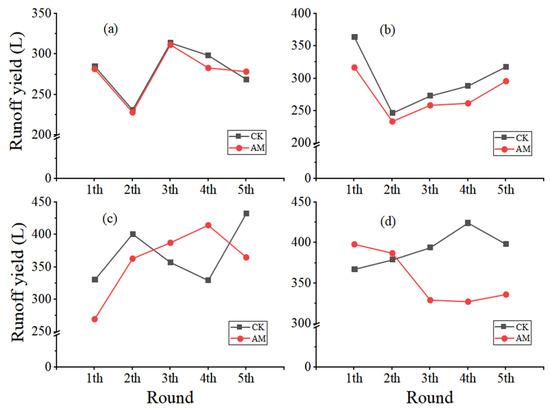
Figure 1.
Variation in runoff yield in different soil troughs under simulated scouring in (a) Cynodon dactylon, (b) Lotus corniculatus, (c) Zoysia japonica, and (d) Astragalus sinicus.
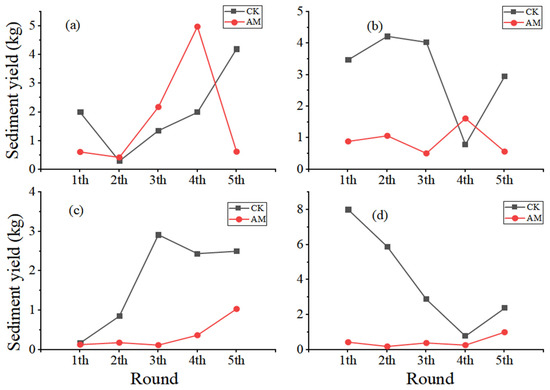
Figure 2.
Variation in sediment yield in different soil troughs under simulated scouring in (a) Cynodon dactylon, (b) Lotus corniculatus, (c) Zoysia japonica, and (d) Astragalus sinicus.
3.3. Variation in Ammonium Nitrogen Loss Concentration in Four Grass Strips
Under continuous scouring, the four grass strips showed a trend in which the runoff ammonium nitrogen loss concentration was smaller in AM treatment than in CK treatment (Figure 3). In C. dactylon, the concentration first decreased and then increased under CK treatment and reached its peak in the fourth scouring time under AM treatment. In Lotus corniculatus, the concentration showed a gradual decrease and tended to be stable under both treatments, whereas in Z. japonica and A. sinicus, the concentration increased and then decreased under both treatments. The loss concentration of sediment ammonium nitrogen in the four grass strips showed a decreasing trend under continuous scouring (Figure 4). Under AM treatment, C. dactylon and L. corniculatus had a decreasing sediment ammonium nitrogen loss concentration compared with CK treatment, whereas that of Z. japonica and A. sinicus under AM treatment was greater than that under CK treatment.
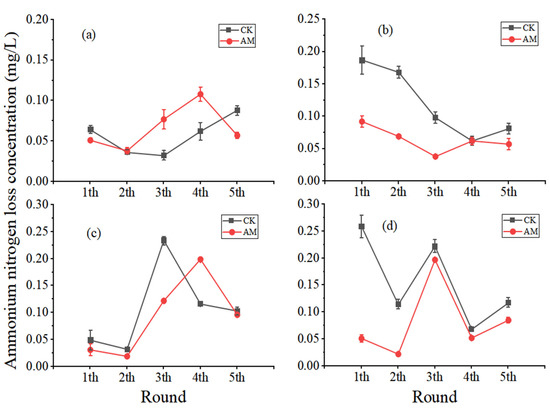
Figure 3.
Variation in runoff ammonium nitrogen loss concentration in different soil troughs under simulated scouring in (a) Cynodon dactylon, (b) Lotus corniculatus, (c) Zoysia japonica, and (d) Astragalus sinicus. Error bars represent ± standard errors.
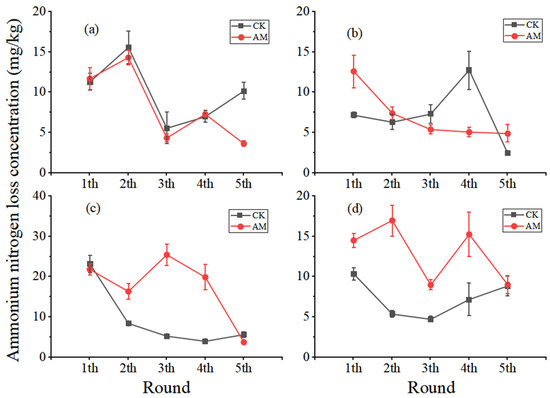
Figure 4.
Variation in sediment ammonium nitrogen loss concentration in different soil troughs under simulated scouring in (a) Cynodon dactylon, (b) Lotus corniculatus, (c) Zoysia japonica, and (d) Astragalus sinicus. Error bars represent ± standard errors.
3.4. Particle Size Distribution of the Produced Sediment in Four Grass Strips
In the four grass strips, the percentage of sediment particle size at >2 mm was significantly higher under CK treatment than under AM treatment (p < 0.05; Figure 5). Except for C. dactylon, the percentage of sediment particle size in other grass strips in the range of 1–2 mm was significantly higher in CK treatment than in AM treatment (p < 0.05). In Z. japonica and A. sinicus under AM treatment, the percentage of sediment particle size in the >2, 1–2, and 0.25–1 mm categories was significantly lower than that of CK treatment (p < 0.05), whereas the percentage of sediment particles in the 0.02–0.25 and <0.02 mm categories was significantly larger than that of CK treatment (p < 0.05). Except for C. dactylon, the percentage of sediment particle size of other grass strips in the range of 0.02–0.25 mm was significantly lower in CK treatment than in AM treatment (p < 0.05). In the four grass strips, the percentage of sediment particle size at 1–2 mm was significantly smaller than that of sizes 0.25–1 mm and 0.02–0.25 mm. In Z. japonica, the percentage of sediment particle size at 0.02–0.25 mm and <0.02 mm was significantly higher than that of other particle sizes (p < 0.05).
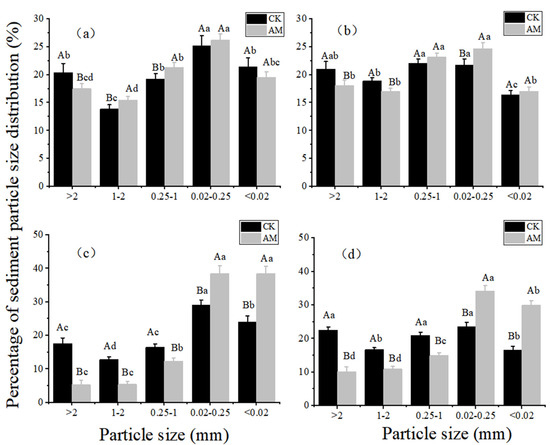
Figure 5.
Sediment particle size distribution in different soil troughs under simulated scouring in (a) Cynodon dactylon, (b) Lotus corniculatus, (c) Zoysia japonica, and (d) Astragalus sinicus. Different capital letters indicate significant differences in the same particle size between different treatments (p < 0.05), and different lowercase letters indicate significant differences between different particle sizes in the same treatment (p < 0.05). Error bars represent ± standard errors.
3.5. Mean Weight Diameter (MWD) and Fractal Dimension (D) of Sediments in Grass Strips
The mean weight diameter (MWD) showed an overall increasing trend with the increase in scouring time (Figure 6). At the fifth scouring time in Z. japonica and A. sinicus under AM treatment, MWD showed a sharp increase, and MWD of sediments produced by the four grass strips under CK treatment was generally larger than that under AM treatment. With the increase in scouring times, the fractal dimension (D) of the generated sediment decreased (Figure 7). D of sediments produced by L. corniculatus in each scouring time was larger in CK than in AM treatment, whereas in Z. japonica and A. sinicus, D was larger in AM than in CK under continuous scouring.
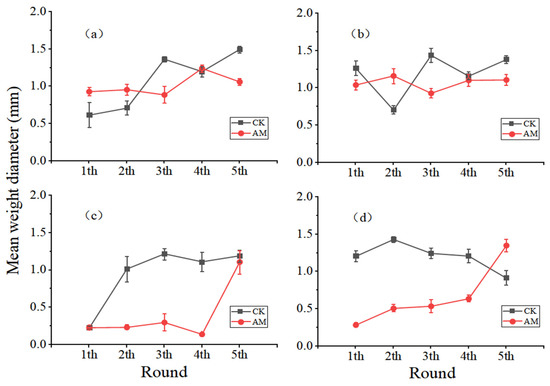
Figure 6.
Variation in sediment MWD in different soil troughs under simulated scouring in (a) Cynodon dactylon, (b) Lotus corniculatus, (c) Zoysia japonica, and (d) Astragalus sinicus. Error bars represent ± standard errors.
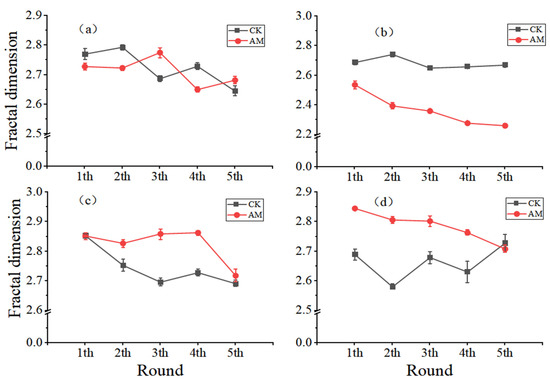
Figure 7.
Variation in sediment D in different soil troughs under simulated scouring in (a) Cynodon dactylon, (b) Lotus corniculatus, (c) Zoysia japonica, and (d) Astragalus sinicus. Error bars represent ± standard errors.
4. Discussion
4.1. Effects of AMF and Grass Strips on the Hydraulic Characteristics of Runoff
Red sandstone has special properties, such as strong physical weathering, water softening, disintegration and fragmentation, and strength reduction, which lead to poor red soil structure in red sandstone development and easy loss of water, soil, and nutrients, thus forming eroded badlands [21]. Most notably, in the case of abundant rainfall in southern China, the red sandstone erosion area has been difficult to control; thus, the study of runoff characteristics in this area is very important. Runoff is the fundamental driving force of slope erosion and the carrier of sediment movement. Its velocity is an important parameter for characterizing the sediment transport capacity of soil erosion. Clarifying the variation characteristics of runoff velocity is of great significance for understanding the hydrodynamic mechanism on a slope and the occurrence and development of erosion [22]. At present, many studies have been carried out on runoff velocity and its influencing factors, and a basically consistent understanding has been obtained; flow velocity is affected mainly by flow, slope gradient, slope roughness, and surface vegetation [23,24]. As an important surface cover, plants significantly affect runoff velocity [25]. At present, some scholars have studied the variation characteristics of flow velocity on the downhill surface of vegetation cover using simulated rainfall and water discharge scouring experiments [26]. Plants can significantly reduce flow velocity by increasing surface roughness, and the degree of reduction is related to plant species [27]. The runoff flow velocity with C. dactylon and A. sinicus under AM treatment was significantly lower than that under CK treatment (Table 2), and the runoff depth of C. dactylon under AM treatment was significantly lower than that under CK treatment. This may be because AMF have a good promotional effect on the growth of C. dactylon and A. sinicus roots, enhancing the mechanical blocking ability of roots to resist runoff erosion, and reducing the runoff flow velocity and runoff depth compared with CK treatment. Furthermore, runoff width of the four grass strips under AM treatment was significantly greater than CK treatment, which may have been due to the enhanced ability of AMF to resist hydraulic erosion of plant roots. This study showed that soils with AMF significantly reduced runoff flow velocity, the runoff generated under continuous scouring was dispersed, and the runoff width was significantly increased compared with CK treatment. Runoff flow velocity, runoff depth, and runoff width are important characteristic parameters that reflect slope runoff. The slope runoff flow velocity is larger, the erosion ability of slope runoff is stronger, and the stripping and transportation ability of water flow to soil increases with an increase in flow velocity. This study showed that grass strips cultivated in soil with AMF had a significant reduction effect on runoff flow velocity and runoff depth while runoff width expanded.
4.2. Effects of AMF and Grass Strips on Runoff and Sediment Yield
It is an important reference for evaluating whether the utilization of grass strips in soil and water conservation is reasonable to explore changes in the influence of grass strips on slope soil flow and sediment production [28]. In this study, the results of this experiment showed that the total runoff yield of the four grass strips under the CK treatment was greater than AM treatment, the total runoff yield of C. dactylon under the two treatments was lower than the other grass strips, and the total yield of A. sinicus was the largest among the four grass strips (Figure 1). The total sediment yield of the four grass strips under continuous scouring was greater under CK treatment than under AM treatment, and the sediment yield of Z. japonica was the smallest in the four grass strips under the CK and AM treatments (Figure 2). These results showed that AM fungi had a good effect on reducing runoff and sediment yield, mainly because AM fungi are a class of soil microorganisms that exist widely in the soil environment and can form mutual benefits with more than 92% of terrestrial plants in the symbiotic system [29]. The glomamycin-related soil proteins secreted by AM fungi can improve soil water-stable aggregates, soil permeability, and water-holding capacity [30]. Different plants have different responses to the growth-promoting effect of AM fungi [31]; for example, Klironomos found that the same AM fungi can promote or inhibit the growth of different plants in a study of 64 plants, reflecting the diversity of AM fungi affecting plant growth [32]. Herbaceous plant roots can enhance the antiscour performance of soil [33]. AM fungi have different effects on the root growth of different plants, which will lead to differences in the soil antiscour performance of different plants. In this study, C. dactylon had the best effect on runoff control, Z. japonica had the best effect on sediment control, and both showed the effect of reducing runoff and sediment yield under AM fungi.
4.3. Effects of AMF and Grass Strips on Ammonium Nitrogen Loss Concentrations in Runoff and Sediment
Nitrogen is one of the most demanded nutrient elements during plant growth, and nitrogen is the main limiting factor for the primary productivity of terrestrial ecosystems [34]. Nitrogen is a key limiting nutrient element in many ecosystems; plants mainly obtain nitrogen in the soil through inorganic forms. Among them, NH4+ and NO3− are the two basic inorganic nitrogen sources that are most easily absorbed and utilized by plants in soil. Nitrogen exists mostly in organic form, and the uptake of organic nitrogen by plants relies on microorganisms to break it down into inorganic forms [35]. In this study, the runoff ammonium nitrogen loss concentration of the four grass strips showed a trend of AM treatment less than CK treatment under continuous scouring (Figure 3), which may be because AM fungi promoted the growth of grass roots and enhanced soil stabilization. Therefore, it can effectively maintain soil and water and reduce the risk of nitrogen loss caused by soil erosion. The ammonium nitrogen loss concentration of sediment in the four grass strips showed a decreasing trend under continuous scouring (Figure 4). Under AM treatment, C. dactylon and L. corniculatus showed a decreasing trend in sediment ammonium nitrogen loss concentration compared with CK treatment. The results indicated that AM fungi had a better effect on the root systems of C. dactylon and L. corniculatus to hold water and soil.
4.4. Effects of AMF and Grass Strips on the Particle Size Distribution of Sediments
In this study, the percentage of sediment particle size in the four grass strips >2 mm was significantly higher under CK treatment than under AM treatment (p < 0.05; Figure 5). The sediment content percentage of Z. japonica and A. sinicus in the large particle size ranges of >2, 1–2, and 0.25–1 mm under the CK treatment was significantly higher than that in the AM treatment, whereas the sediment content in the small particle size ranges of 0.02–0.25, and <0.02 mm was significantly higher under AM treatment than under CK treatment. Studies have shown that AMF can regulate root morphological development [36]. The hyphae of AMF can provide a good rhizosphere environment for plants, and by enhancing nutrient absorption and improving photosynthetic efficiency, they can enhance the ability of the host plants to absorb nutrients, improve plant nutrient levels, improve plant stress resistance, and promote plant growth in nutrient-poor soil. The combination of AMF and plants can improve soil physicochemical properties and rhizosphere microbial communities [37] and has the potential to help plants adapt and transform the soil environment. By promoting the growth in plant roots, the anchoring effect on the soil was strengthened; therefore, the loss of larger-size sediments was reduced in the AM treatment compared with the CK treatment, especially in the particle size range of >2 mm. The mean weight diameter (MWD) showed an overall increasing trend with the increase of scouring time (Figure 6). The agglomerate degree of the lost sediment particles increased under continuous scouring, whereas the fractal dimension (D) decreased under continuous scouring (Figure 7). Because the rills developed faster under continuous scouring, the runoff convergence capacity in the rills was greater, the disintegration of soil particles was faster, and the content of larger particles of sediment was higher. The mean weight diameter (MWD) of sediments produced by the four grass strips under CK treatment was larger than that under AM treatment (Figure 6). Under CK treatment, the fractal dimension (D) of Z. japonica and A. sinicus under continuous scouring was smaller than that under AM treatment (Figure 7). The sediment particle size produced by continuous scouring under CK treatment was generally larger than that under AM treatment.
5. Conclusions
In this study, using benomyl to kill the original AMF in the soil as a control, we analyzed the runoff and sediment characteristics of four grass strips under five scouring times. The runoff velocity of C. dactylon and A. sinicus under AM treatment was significantly lower than CK treatment, and the total runoff and sediment yields of the four grass strips under CK treatment were greater than AM treatment. This result indicated that AMF have had a significant effect on reducing soil erosion in red sandstone erosion areas in southern China. The runoff ammonium nitrogen loss concentration of the four grass strips was lower in AM treatment than in CK treatment under continuous scouring, and the ammonium nitrogen loss concentration of sediment gradually decreased under continuous scouring. The concentration of ammonium nitrogen loss in the sediments of C. dactylon and L. corniculatus under AM treatment decreased compared with that under CK treatment. These results indicated that AMF could effectively inhibit the loss of ammonium nitrogen in red soil in southern China and play an important role in maintaining soil nutrients. The percentage of sediment particle size >2 mm in the four grass strips was significantly higher under CK treatment than under AM treatment (p < 0.05), and except for C. dactylon, the percentage of sediment particle size in the range of 1–2 mm for other grass strips was significantly higher under CK treatment than under AM treatment (p < 0.05). The percentage of sediment particle size at 0.02–0.25 mm was significantly lower under CK treatment than under AM treatment (p < 0.05). The mean weight diameter (MWD) of sediments produced by the four grass strips under simulated scouring increased with the increase in scouring time. The mean weight diameter (MWD) of the four grass strips under CK treatment was generally larger than that under AM treatment, and the fractal dimension (D) of sediments produced by the four grass strips under simulated scouring decreased with the increase in scouring time. These results comprehensively showed that AMF could promote the growth of plant roots, strengthen soil anchoring, protect large particle aggregates in soil under rainfall scouring, and reduce soil erosion and nutrient loss in red sandstone erosion areas in southern China. C. dactylon and Z. japonica were the most prominent in inhibiting soil erosion in red sandstone erosion areas in southern China.
Author Contributions
Conceptualization, L.Z., T.X., H.L. and X.Z.; methodology, L.Z., T.X., H.L., J.X., P.G., C.D. and W.Z.; validation, L.Z., T.X., H.L. and W.Z.; data curation and analysis, T.X., L.Z. and H.L.; writing—review and editing, T.X., L.Z., H.L., J.X. and X.Z.; T.X. and L.Z. contributed equally to this work and share first authorship. All the authors contributed substantially to the revisions of the manuscript. All authors have read and agreed to the published version of the manuscript.
Funding
This research was jointly financially supported by the National Key Research and Development Program of China (No.2020YFD1100603-02), the National Natural Science Foundation of China (No.41967012), the Jiangxi Provincial Natural Science Foundation of China (No.20192BAB214007), Postdoctoral Projects in Jiangxi Province of China (No.2020KY47), the Water Conservancy Science and Technology Program of Jiangxi Province of China (No.201922ZDKT10; 202224ZDKT17; 202223TGKT03).
Institutional Review Board Statement
Not applicable.
Informed Consent Statement
Not applicable.
Data Availability Statement
Not applicable.
Acknowledgments
We would like to thank Xiao-Jun Liu, Ai-Lan Hu, Xiao-Yuan Lu, Jing-Qiu Zhong for their help with field sampling and laboratory measurement.
Conflicts of Interest
The authors declare no conflict of interest.
References
- Ahmad, N.N.S.B.; Mustafa, F.B.; Yusoff, S.Y.M.; Didams, G. A systematic review of soil erosion control practices on the agri-cultural land in Asia. Int. Soil Water Conserv. Res. 2020, 8, 103–115. [Google Scholar] [CrossRef]
- Li, N.; Zhang, Y.; Wang, T.W.; Li, J.W.; Yang, J.W.; Luo, M.Y. Have anthropogenic factors mitigated or intensified soil erosion over the past three decades in South China? J. Environ. Manag. 2022, 302, 114093. [Google Scholar] [CrossRef] [PubMed]
- Liang, Y.; Li, D.; Lu, X.X.; Yang, X.; Pan, X.; Mu, H.; Shi, D.; Zhang, B. Soil erosion changes over the past five decades in the red soil region of Southern China. J. Mt. Sci. 2010, 7, 92–99. [Google Scholar] [CrossRef]
- Mao, Y.-T.; Hu, W.; Chau, H.W.; Lei, B.-K.; Di, H.-J.; Chen, A.-Q.; Hou, M.-T.; Whitley, S. Combined Cultivation Pattern Reduces Soil Erosion and Nutrient Loss from Sloping Farmland on Red Soil in Southwestern China. Agronomy 2020, 10, 1071. [Google Scholar] [CrossRef]
- Ma, D.; Duan, H.; Li, X.; Li, Z.; Zhou, Z.; Li, T. Effects of seepage-induced erosion on nonlinear hydraulic properties of broken red sandstones. Tunn. Undergr. Space Technol. 2019, 91, 102993. [Google Scholar] [CrossRef]
- Feng, M.; Wu, J.; Ma, D.; Ni, X.; Yu, B.; Chen, Z. Experimental investigation on the seepage property of saturated broken red sandstone of continuous gradation. Bull. Eng. Geol. Environ. 2018, 77, 1167–1178. [Google Scholar] [CrossRef]
- Huang, Z.; Ouyang, Z.; Li, F.; Zheng, H.; Wang, X. Response of runoff and soil loss to reforestation and rainfall type in red soil region of southern China. J. Environ. Sci. 2010, 22, 1765–1773. [Google Scholar] [CrossRef]
- Shi, X.Z.; Wang, H.J.; Yu, D.S.; David, C.W.; Cheng, X.F.; Pan, X.Z.; Sun, W.X.; Chen, J.M. Potential for soil carbon seques-tration of eroded areas in subtropical China. Soil Tillage Res. 2008, 105, 322–327. [Google Scholar] [CrossRef]
- Zhu, X.; Liang, Y.; Qu, L.; Cao, L.; Tian, Z.; Liu, T.; Li, M. Characteristics of runoff and sediment yield for two typical erodible soils in southern China. Int. J. Sediment Res. 2022, 37, 653–661. [Google Scholar] [CrossRef]
- Zhu, X.; Liang, Y.; Cao, L.; Tian, Z.; Li, M. Pore characteristics of physical crust samples from two typical erodible soils in southern China. Eur. J. Soil Sci. 2022, 73, e13234. [Google Scholar] [CrossRef]
- Yang, S.-Q.; Jing, H.-W.; Cheng, L. Influences of pore pressure on short-term and creep mechanical behavior of red sandstone. Eng. Geol. 2014, 179, 10–23. [Google Scholar] [CrossRef]
- Ayed, G.M.; Mohammad, A.A. The impact of vegetative cover type on runoff and soil erosion under different land uses. Catena 2010, 81, 97–103. [Google Scholar]
- Zhang, X.; Wang, Z. Interrill soil erosion processes on steep slopes. J. Hydrol. 2017, 548, 652–664. [Google Scholar] [CrossRef]
- Pan, D.; Yang, S.; Song, Y.; Gao, X.; Wu, P.; Zhao, X. The tradeoff between soil erosion protection and water consumption in revegetation: Evaluation of new indicators and influencing factors. Geoderma 2019, 347, 32–39. [Google Scholar] [CrossRef]
- Asmelash, F.; Bekele, T.; Birhane, E. The Potential Role of Arbuscular Mycorrhizal Fungi in the Restoration of Degraded Lands. Front. Microbiol. 2016, 7, 1095. [Google Scholar] [CrossRef]
- Khalid, M.E.; Ahmed, S.E.; Abdallah, M.E. The impact of arbuscular mycorrhizal fungi in mitigating salt-induced adverse effects in sweet basil (Ocimum basilicum L.). Saudi J. Biol. Sci. 2017, 24, 170–179. [Google Scholar]
- Sun, X.-G.; Tang, M. Effect of arbuscular mycorrhizal fungi inoculation on root traits and root volatile organic compound emissions of Sorghum bicolor. S. Afr. J. Bot. 2013, 88, 373–379. [Google Scholar] [CrossRef]
- Alessandra, S.; Paola, B. Systems biology and “omics” tools: A cooperation for next-generation mycorrhizal studies. Plant Sci. 2013, 203, 107–114. [Google Scholar]
- Priya, B.; Pragati, P.M.; Mrinmoy, R.; Nilimesh, M. Prediction of mean weight diameter of soil using machine learning approaches. Agron. J. 2021, 113, 1303–1316. [Google Scholar]
- Abbas, A.; Mohammad-Reza, N.; Hassan, R.; Hossein, A. Fractal dimension of soil aggregates as an index of soil erodibility. J. Hydrol. 2011, 400, 305–311. [Google Scholar]
- Wang, T.; Song, Z.; Yang, J.; Zhang, Q.; Cheng, Y. A Study of the Dynamic Characteristics of Red Sandstone Residual Soils Based on SHPB Tests. KSCE J. Civ. Eng. 2021, 25, 1705–1717. [Google Scholar] [CrossRef]
- Chang, E.; Li, P.; Li, Z.; Su, Y.; Zhang, Y.; Zhang, J.; Liu, Z.; Li, Z. The Impact of Vegetation Successional Status on Slope Runoff Erosion in the Loess Plateau of China. Water 2019, 11, 2614. [Google Scholar] [CrossRef]
- Han, D.; Deng, J.; Gu, C.; Mu, X.; Gao, P.; Gao, J. Effect of shrub-grass vegetation coverage and slope gradient on runoff and sediment yield under simulated rainfall. Int. J. Sediment Res. 2021, 36, 29–37. [Google Scholar] [CrossRef]
- Deng, L.Z.; Sun, T.Y.; Fei, K.; Zhang, L.P.; Fan, X.J.; Wu, Y.H.; Ni, L. Effects of erosion degree, rainfall intensity and slope gra-dient on runoff and sediment yield for the bare soils from the weathered granite slopes of SE China. Geomorphology 2020, 352, 106997. [Google Scholar] [CrossRef]
- Wei, W.; Jia, F.; Yang, L.; Chen, L.; Zhang, H.; Yu, Y. Effects of surficial condition and rainfall intensity on runoff in a loess hilly area, China. J. Hydrol. 2014, 513, 115–126. [Google Scholar] [CrossRef]
- Duan, J.; Liu, Y.-J.; Wang, L.-Y.; Yang, J.; Tang, C.-J.; Zheng, H.-J. Importance of grass stolons in mitigating runoff and sediment yield under simulated rainstorms. Catena 2022, 213, 106132. [Google Scholar] [CrossRef]
- Zhang, X.; Yu, G.Q.; Bin Li, Z.; Li, P. Experimental Study on Slope Runoff, Erosion and Sediment under Different Vegetation Types. Water Resour. Manag. 2014, 28, 2415–2433. [Google Scholar] [CrossRef]
- Willemijn, M.A.; Patrick, W.B.; Sjoerd, E.A.T.M. Surface runoff in flat terrain: How field topography and runoff generating processes control hydrological connectivity. J. Hydrol. 2016, 534, 493–504. [Google Scholar]
- Parniske, M. Arbuscular mycorrhiza: The mother of plant root endosymbioses. Nat. Rev. Genet. 2008, 6, 763–775. [Google Scholar] [CrossRef]
- Rillig, M.C.; Mummey, D.L. Mycorrhizas and soil structure. New Phytol. 2006, 171, 41–53. [Google Scholar] [CrossRef]
- Smith, S.E.; Smith, F.A.; Jakobsen, I. Mycorrhizal Fungi Can Dominate Phosphate Supply to Plants Irrespective of Growth Responses. Plant Physiol. 2003, 133, 16–20. [Google Scholar] [CrossRef] [PubMed]
- John, N.K. Variation in Plant Response to Native and Exotic Arbuscular Mycorrhizal Fungi. Ecology 2003, 84, 2292–2301. [Google Scholar]
- Xu, W.-X.; Yang, L.; Bao, Y.-H.; Li, J.-L.; Wei, J. Soil anti-scourability enhanced by herbaceous species roots in a reservoir water level fluctuation zone. J. Mt. Sci. 2021, 18, 392–406. [Google Scholar] [CrossRef]
- Schneider, S.; Schintlmeister, A.; Becana, M.; Wagner, M.; Woebken, D.; Wienkoop, S. Sulfate is transported at significant rates through the symbiosome membrane and is crucial for nitrogenase biosynthesis. Plant Cell Environ. 2019, 42, 1180–1189. [Google Scholar] [CrossRef]
- Hodge, A.; Campbell, C.; Fitter, A.H. An arbuscular mycorrhizal fungus accelerates decomposition and acquires nitrogen directly from organic material. Nature 2001, 413, 297–299. [Google Scholar] [CrossRef]
- Wu, Q.-S.; Zou, Y.-N.; He, X.-H. Contributions of arbuscular mycorrhizal fungi to growth, photosynthesis, root morphology and ionic balance of citrus seedlings under salt stress. Acta Physiol. Plant. 2010, 32, 297–304. [Google Scholar] [CrossRef]
- Almudena, M.; Rosario, A. Effectiveness of the application of arbuscular mycorrhiza fungi and organic amendments to improve soil quality and plant performance under stress conditions. J. Soil Sci. Plant Nutr. 2010, 10, 354–372. [Google Scholar]
Publisher’s Note: MDPI stays neutral with regard to jurisdictional claims in published maps and institutional affiliations. |
© 2022 by the authors. Licensee MDPI, Basel, Switzerland. This article is an open access article distributed under the terms and conditions of the Creative Commons Attribution (CC BY) license (https://creativecommons.org/licenses/by/4.0/).